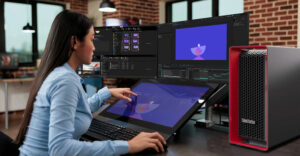
The U.S. stock market had a really happy week last week. The market was on a long rally, and a number of high-profile technology vendors made interesting moves. The first was the release of Dell’s Adamo product — the first laptop offering that really was rethought as more of an art project than a typical laptop. While expensive, it actually feels worth it. The second was the leak that Sun was about to be acquired by IBM for US$7 billion, which has to have old time IBMers dancing in the aisles. Sun pounded on IBM a lot in the ’90s.
For the product of the week, I have chosen Internet Explorer 8 — a vastly improved product from Microsoft, which should reduce significantly the market erosion Microsoft has been experiencing in the browser segment.
Dell’s Adamo: Laptop Art
One of the problems with the car market is that automakers will bring out these wonderful-looking prototypes at an auto show with the promise of a wonderful car you can buy later. Unfortunately, what we eventually get is generally a lot less exciting. The Chevy Volt — what was promised vs. what we are getting — is an example. Still, and my Infiniti FX45 is an example of this, from time to time they actually bring out what they promise. The result — for those few who don’t want the original vision the designer imagined compromised — is one of those rare wonderful moments when you can buy practical art.
The Adamo, and I’ve had one for several days now, is an amazing product. With this offering, you don’t focus on speeds and feeds. You focus on how the laptop looks, how it feels, how people seem to catch their breath when they see it, and the slight hint of envy in their eyes. It is heavier than other products in its class by intention — not a lot heavier, a little less than a pound — but that weight is designed to both give the product better balance and to make it feel luxurious.
The black one I got for evaluation has a cover that looks like brushed steel. The glass insert on the lid both helps the balance and gives the product the deepest clear-coat surface you are likely to see short of high-end furniture. The power supply has this same brushed metal finish, and there is a line of accessories that includes custom Adamo bags and matching optical drive.
The MacBook Air, Lenovo X301 and HP Voodoo Envy are all in this same class. The MacBook runs the Mac OS, the Lenovo excels in both durability and practicality, and the Voodoo leads in performance and weight — it uses a unique graphite case.
However, the Dell Adamo is a statement product — one of the few that qualify as true desk art. Few of you can afford it or will buy it, but everyone should check it out.
Sun Sets in IBM’s Backyard
Last week, it was leaked that IBM was looking to buy Sun. What an incredibly powerful statement that is on how much IBM has changed and improved since Sam Palmisano took over. He has basically turned IBM into a company that is more like Microsoft than either the old IBM or HP, with the one unique advantage of having the strongest services unit on the planet. This is a far cry from the IBM of the early ’90s that Sun was kicking all over the market while laughing gleefully at IBM’s expense.
Well, Sun got too focused on Microsoft, and the end result was that Dell, HP and IBM ate its lunch. Ironically, Sunhad to beg Microsoft for money for much of this decade — and now IBM appears to be thinking about buying Sun. I doubt IBM is interested in the company or the brand. Basically, it wants what Sun has, not Sun the company.
In terms of hardware, the addition of Sun’s market share should put IBM in the lead in most server categories. If it keeps most of Sun’s customer-facing folks — as I expect it will — IBM may be able to hold onto much of that share. However, it is likely Sun’s IP that IBM wants — not the facilities or the brand.
On the hardware side, there is likely some interesting stuff that IBM’s microelectronics and server groups might want, but it is the software side that looks especially interesting. The most visible is probably Java, which is one of the major Web platforms and is core to Google’s Android and Research In Motion’s BlackBerry platform.
Sun also has JavaFX, which moves against Silverlight from Microsoft and Flash from Adobe. It has OpenOffice.org, which is the foundation beneath IBM’s Lotus Symphony offering. In addition, Sun has a group that appears to have a Second-Life-like offering for business conferencing — and IBM has been a huge supporter of Second Life.
There is some speculation that Solaris is the source of many of the core components in the current generations of Linux, and that IBM’s acquisition could prevent another SCO event in the future, should someone less friendly acquire Sun instead.
This is one to watch, but the fact that IBM/Sun is in play is testament to the job that Palmisano has done to transform IBM into a player in the new world we all have to live in.
Product of the Week: Internet Explorer Version 8
When a product achieves the level of dominance that IE had achieved — as Netscape Navigator failed in the market — the vendor that owns it tends to figure the battle is won, and it can now focus on other things. The end result is that competitors spring up, and the market share it thought it owned starts to drift away at an increasing rate. That’s what happened in the IE6 and IE7 time frames.
In reality, Firefox is the only real contender in global usage. Firefox has about 22 percent, Apple Safari has about 8 percent, and the rest is mostly noise. From Q4 2004 to Q1 2009, IE dropped from 91 percent share to 67 percent share, so Microsoft clearly needed to do something.
IE8 is vastly better than IE7. I’ve been using it in beta form since the beginning of the year. It is faster; it is less annoying, and it is vastly more compatible than its predecessors. We lack the comprehensive benchmarks we need to actually determine if it’s faster than Firefox, Opera or Safari. However, as the dominant product, it doesn’t need to be faster — it just has to avoid being slow or so annoying that people feel they need to switch.
IE8 appears to have the most comprehensive defense against social malware currently in the market, according to NSS Labs. It did almost immediately get hacked at the CanSecWest conference, but that is not uncommon. Safari was hacked at the same conference.
Microsoft put a lot of work into this, but I’m not sure how much any browser vendor can actually do to create the security we need, given that attacks seem to focus on the weakest link: the user. In the end, we’re what needs to be fixed.
Will IE8 bring people back who switched? I doubt it, because people have to become annoyed with what they are using to switch, and I’m not seeing that problem with any of the contenders. However, it should slow significantly the market erosion IE was experiencing — if not stop it — and that would be good enough. For the majority of us on IE, the improvements are well received.
What can I say? I still use IE myself, and fixing something I use as much as a browser — and the fact that it’s still free — makes IE8 my product of the week.
Rob Enderle is a TechNewsWorld columnist and the principal analyst for the Enderle Group, a consultancy that focuses on personal technology products and trends.




















































